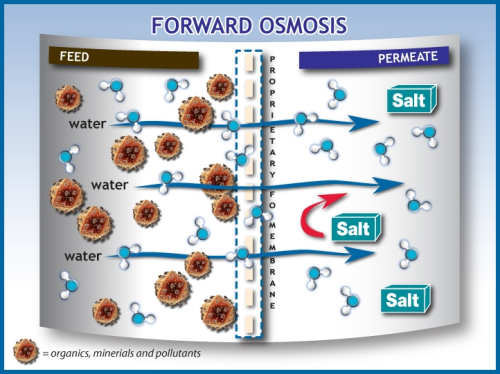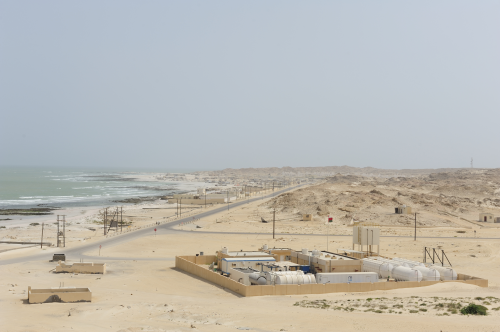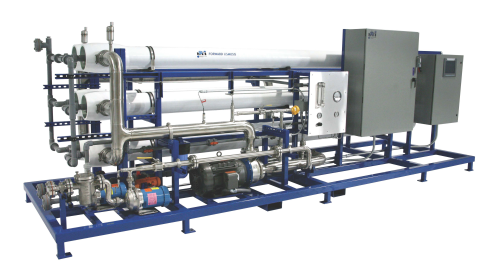



Osmosis and membrane technology
The established membrane technology in large scale desalination projects is reverse osmosis (RO), where total dissolved solids (TDS) present in the feed supply are concentrated to produce the rejected concentrate stream. Other approaches include direct osmosis processes.
RO operates by applying high pressure to the saltwater side of the membrane to initially overcome the osmotic pressure and then drive water from the saline to the freshwater side of the membrane.
Osmosis is a spontaneous process in which water is transported through a semi-permeable membrane due to a difference in chemical potential between two solutions. Water will naturally diffuse through the membrane from the freshwater side to dilute the higher saline solution. Compared to reverse osmosis, direct osmosis might not seem to be useful as the process provides a smaller quantity of freshwater and a larger quantity of diluted saltwater.
However, direct osmosis processes offer novel approaches. There is the potential for harnessing energy through exploiting the osmotic principle. Systems that use the direct osmosis principle are called forward osmosis (FO) systems. Energy recovery schemes are normally termed pressure retarded osmosis (PRO) processes. A number of variants and combinations of these process schemes are now described.
Walt Schultz at Hydration Technology Innovations (HTI) said: “FO is inherently a low fouling membrane process powered by a draw solution on the permeate side of the membrane. The draw solution must have a higher osmotic pressure than the feed water. In FO, clean water diffuses across the membrane and dilutes the draw solution, leaving foulants and contaminates behind.” The principle is illustrated in Figure 2.
Manufacturers and systems specialists
Ali Altaee at the University of the West Scotland and Eric Hoek at the University of California in Los Angeles advise some of the main players in the developing FO industry. “The FO companies can be divided into primarily membrane manufacturing companies and process development and operation companies,” Mr Altaee explained.
Membrane manufacturers include HTI, Oasys Water, Porifera and Aquaporin whilst Modern Water, HTI, StatKraft, Trevi Systems and Desalgae Water are examples of process developers.
The main interest of StatKraft is PRO for power generation. “There are a number of companies and institutes in Spain, USA, Japan and many other countries working on the development of PRO technology,” Mr Altaee said.
Mr Hoek added: “Of the established membrane manufacturers, Hydranautics appears to have taken the greatest interest in FO through its collaboration with StatKraft, but earlier this year Toray announced it is developing high flux osmotic membranes too. If more commercially viable draw solute recovery processes emerge the FO market size will increase. Then, I suspect we will see more large membrane manufacturers begin developing FO membranes.”
HTI manufactures forward osmosis flat sheet membranes using cellulose chemistry as well as a thin film composite (TFC) membrane using polysulphone and other polymer chemistry, and produces each membrane with various support structures to meet application requirements. HTI fabricates these membranes into various sizes of spiral membrane elements, and then engineers, fabricates and delivers integrated FO system equipment (see Figure 3), including hybrid FO/RO systems.
Issues and opportunities
“The main technical question,” Leon Awerbuch at the International Desalination Association explained, “is the amount of energy needed to regenerate draw solutions of concentrated brine or thermolytic salts, in the case of Oasys Water.”
We have said that water flows by osmosis through a membrane from the feed water into the draw solution. “For it to do this,” James Birkett at West Neck Strategies highlighted, “it must be entering a lower state of chemical free energy. Therefore it takes more energy to extract the pure water from the draw solution than it does to extract it from the feed water.
“The proponents of FO rarely mention this. They state that it uses less electrical energy than RO. This may be the case, depending on designs, but other energy must be consumed to regenerate the draw solution and get the fresh water out. It can be argued that this is just waste heat so it’s free or cheap and doesn’t really matter. Waste heat is called that because it usually requires significant capital expense to get useful work out of it.
“The challenge in FO is indeed the regeneration of the draw solution, not the membrane itself,” Mr Birkett asserted, and went on to outline the following issues:
Draw solution regeneration must be simple and fast, with a low hydraulic retention time to reduce size of equipment. Regeneration must be complete with no loss of the draw solute, otherwise costs increase. As product water is in contact with the draw solution, the latter must be completely non-toxic.
Focusing on the advantages of FO, Mr Altaee added: “Generally speaking, FO is low fouling and suitable for a wide range of feed salinities. And if you exclude the regeneration of the draw solution the process has lower power consumption than RO. FO also has a high membrane permeability and rejection rate, a relatively high recovery rate, it’s modular, can be retrofitted to an existing plant, and it’s reliable technology.”
Mr Hoek told us that, in his opinion, there is little evidence at commercial water treatment scales that FO offers any fundamental advantages over RO. “But there is theoretical and some empirical evidence that FO could enable some really interesting process engineering possibilities,” he added.
“For example, the idea of using FO to draw fresh water from tertiary wastewater effluent using seawater, then using RO to desalt the diluted seawater could allow existing desalination plants to reduce energy demand or increase water recovery, albeit at the expense of greater capital and operating costs.”
“Also,” Mr Hoek added, “there seems to be better fouling resistance and clean-ability associated with FO membranes relative to RO but it’s unclear whether this is due to the commercially available membrane materials, process nuances, or some combination thereof. I would say this is not yet settled scientifically.”
Mr Birkett added: “Raw seawater is a complex chemical and biological soup. Until serious direct testing has been done, it is wishful thinking to conclude that FO is low fouling and problem free.”
Desalination developments
Economics
HTI, for example, has investigated desalination both internally and with external groups attempting to develop seawater forward osmosis. “We just don’t yet see that as a ripe commercial market,” Mr Schultz commented, “and development effort is still needed regarding high strength draw solutions from which water can be recovered with less energy than RO.
“We still run into many people thinking they can defy the laws of thermodynamics in recovering draw solutions from FO permeate, but it can’t be done. HTI believe it’s clear that FO done with conventional inorganic salts as the draw solution is probably not competitive with seawater reverse osmosis for traditional desalination, but is competitive and advantageous when de-watering difficult wastewaters.
“A lot of work has focused on new draw solutions using magnetic particles, polymeric or organic salts, and other speciality osmolytes. However, the promising new draw solutions all remain in the development stage, and the jury is out on the amount of energy required for water recovery and how to re-concentrate the draw solution without carryover to the clean permeate or contamination of the feed water.
“Desalination is driven by economics, and unless seawater FO can be cheaper and more efficient than conventional RO, it is a non-starter. That said, we are encouraged and continue to invest in this area,” Mr Schultz concluded.
Osmotic dilution
As the shortage of available fresh water continues to be stretched, direct potable reuse of wastewater is becoming a reality and is beginning to be accepted.
“As that trend continues,” Mr Shultz explained, “osmotic dilution with FO promises a high value complementary process to bolt on to seawater RO plants, using FO with seawater or RO reject as the draw solution, to filter the wastewater used to blend with seawater and dilute the feed to the RO.” HTI advises that it has quantified the economic benefit of this FO/RO synergy and is currently proving the concept through a demonstration plant.
Case study
An example of an operating plant in the desalination industry is Al Khaluf, a site 400 km south of Muscat, incorporating Modern Water’s 100m3 per day containerised unit which operates alongside a conventional SWRO system owned by the Public Authority for Electricity and Water. The FO part of the process operates at 35% recovery to dilute the draw solution before it is desalinated by high-pressure SWRO membranes to produce potable water with 120 mg/l TDS.
During desalination, the proprietary osmotic agent in the FO draw solution is concentrated and reused. The diluted feed is reported to reduce desalination energy requirements by more than 20%. Also, the chlorine-tolerant and fouling resistant FO membranes produce a virtually particulate-free feed to the RO process (see Figure 4).
The future
Looking ahead to the likely development of FO technology in desalination over the next 10 years, there were mixed views amongst our experts.
“I truly believe,” asserted Matthew Claxton at Desalgae Water, “that the FO membrane is the answer to some of the major problems in the desalination, water reuse, and biofuel industry. As water scarcity, and contamination, continues to grow, we will see the FO membrane really emerge as an energy efficient way to produce potable drinking water.
“Within the next decade, we will see the technology take off in the market place as more and more companies begin to integrate it into their water purification systems. It will be able to not only decontaminate water for industrial countries, but it will also greatly help Third World countries that do not have the resources to afford the massive energy bill that comes with desalination plants.”
“Desalgae Water is a biofuel and water company dedicated to reinventing the biofuel industry,” explained Mr Claxton, “and providing affordable clean drinking water for all.” The company’s patent pending Desalgae system, invented by Jonathan Trent and Claxton, uses micro-algae and membrane filtration to recycle contaminated water effectively and produce sustainable biofuels.
“In my opinion,” Mr Altaee explained, “more pilot and some small to medium scale FO plants will be commissioned especially for power generation by PRO and seawater softening. The latter process is mainly for the removal of scaling ions such as sulphate, calcium and magnesium from seawater.”
Mr Hoek thought “there would be chipping away at smaller scale applications particularly industrial wastewater treatment and water reuse applications.”
Large scale development over 10 years could be marginal because the industry is inherently conservative. “It is generally not quick to adopt new technologies,” identified Peter Nicoll from Modern Water.
“A good example of this is the time it has taken to have large scale multiple effect thermal desalination plant technology adopted,” Mr Nicoll explained.
“FO can be applied in a variety of ways for desalination,” he added. “It can be applied specifically to produce desalinated water when coupled with either thermal or membrane based technology, such as the FO solution at Al Khaluf, or perhaps more importantly it can be used indirectly.
“The indirect uses, using pure FO, have very significant advantages in particular in energy terms, where a dilution of a draw solution is used. Here the differentiators between any conventional desalination technology and an FO-based process are very clear. I believe that these processes will be adopted more quickly and will displace the use of desalinated water, recognising that water needs to be fit for purpose, no better no worse.
“There is without doubt increasing interest in FO-based processes both academically and in industry,” Mr Nicoll asserted, “but the introduction of this new technology cannot be done without the support of the early adopters. This needs to continue, so that the number and size of the reference plants increase and the clear advantages of the technology are seen in different places, operating on different feed waters and doing different things.”
Developing markets
Applications
Mr Claxton predicted: “FO will increase the number of viable projects in water reuse because of its ability to reject harmful contaminants, and produce clean drinking water with very little energy. This is a blessing for many Third World countries that do not have abundant resources such as money or energy.
“We will also start to see the FO membrane gain traction with algal biofuels as an energy efficient way to harvest algal biomass. A step that can account for 20-30% of biofuel production costs. It really cannot be over stated how the FO membrane will revolutionise the water and bio-fuel industry.”
Mr Awerbuch added: “Some companies are using renewable sources of energy to regenerate draw solutions. Another focus is the use of FO technology for reuse of flowback and produced water in shale fracking operations. And osmotic power and PRO is of significant interest as a source of energy.”
“For water reuse,” Mr Altaee added, “in my opinion FO is a mature technology but there are a number of concerns for large scale commercial applications in addition to the strong competition from RO and thermal desalination processes.
“Although the FO membrane is commercially available, the osmotic agent is still a debatable issue. One of the reasons for this is due to the large number of chemicals which have been proposed as osmotic agents.”
“The interest in the FO market is brisk,” Mr Schultz explained, “with most of the focus on speciality industrial applications where other traditional membrane technologies are not doing a good job. It’s amazing to see how much money is being spent by the industry developing FO separation and dewatering solutions.”
Complimentary technology
FO can be applied in applications where RO is not the right process solution, so we could view it as a complimentary technology. “Most applications relate to separating waste streams,” Mr Schultz explained, “that are highly fouling or have high total suspended solids, and many relate to brine make-up where companies are looking to recycle water and they have concentrated brine available to be the draw solution.
“In industrial applications,” Mr Schultz said, “if the goal is production of clean water for reuse, the draw solution must be separate from the clean water and re-concentrated for use in the FO process.
“We have demonstrated this many times in our work with landfill leachate, oil and gas waste and produced waters, and even in concentration of food products, where we put FO in front of RO to do the hard work and pre-treat the feed to the RO system, running a closed loop draw solution re-concentrated by RO in a complementary process.” In such applications, FO can protect the RO system and facilitate less frequent CIP and prolonged RO membrane life.
“The highest value projects for this closed loop process are applications where RO struggles to perform without fouling and requires expensive and complex pre-treatment,” Mr Schultz added.
In one recent example of a FO/RO hybrid system for recycling wastewater on an oil and gas project, HTI advises the technology offered an overall 45% reduction in cost to the operator, when compared to traditional process solutions.
Markets for FO with the most potential are where there is a difficult waste stream with high TDS. “In applications such as oil and gas produced waters,” Mr Schultz explained, “we use our new HiCor RO technology together with FO and it broadens the scope and capability of FO by providing a much stronger draw solution concentrate without the need for thermal processes or potentially toxic draw solutions.”
HTI developed the HiCor technology with the purpose of re-concentrating FO draw solutions and they state that FO/HiCor can efficiently concentrate FO feed streams with TDS at 50-00 g/l, and provide FO draw solution concentrations as high as 140-160 g/l TDS. The company’s first production scale pilot system is expected to be commissioned by late summer 2013.
Mr Hoek was also uncertain on wide adoption of FO in the near term, but said “I think it can find a niche.” Mr Nicoll agreed. “Without doubt,” he said “but again I would say this will be held back by the conservative nature of the industry.
“FO-based desalination, which is less prone to fouling than conventional membrane processes, can be deployed for direct water reuse. Unlike ultrafiltration, the FO membrane separates at the ionic level and organics are removed in this first step, thus it allows for and provides a greater degree of security.”
Membrane bioreactors
“There is already work being done on osmotic membrane bioreactors by some researchers,” Mr Nicoll added, “and subject to suitable membranes of the right configuration being available with low back diffusion, there is no reason why this could not be deployed.”
“Osmotic MBRs are indeed coming,” Mr Hoek agreed. “HTI already talks about this publicly as being commercially viable along with Desalgae.” Types include aerobic, anaerobic and photosynthetic membrane bioreactors.
“I believe that in 10 years’ time,” Mr Hoek predicted, “osmotic membrane bioreactors could begin to emerge in smaller scale industrial wastewater treatment, reuse and recycling. Depending on the technology improvements and operational experience we might see them begin to take root in municipal markets thereafter.”
“One of the most exciting areas from HTI’s perspective is wastewater treatment and development of Osmotic MBR technology,” Mr Schultz agreed. “This concept is quickly gaining traction where the focus is on recovery of high quality reused water, and is especially beneficial where customers also wish to concentrate and harvest nitrogen, potassium and phosphorus for fertilizer.” Mr Schultz confirmed that HTI, in cooperation with the Colorado School of Mines, has been successfully running an Osmotic MBR under the US National Science Foundation ‘ReNUWit’ programme for over a year.
“Osmotic cleaning is also being developed for backwashing and cleaning of RO membranes. IDE has a patent and my lab has also published on this concept,” Mr Hoek added.
Conclusions
“The more interesting and potentially higher value applications for reuse are where the total water balance is being considered,” Mr Nicoll explained. “For instance, in one area of a process plant something needs to be concentrated, but in another something needs to be diluted. FO may be suitable for doing both these operations in one step with very low energy consumption associated with the frictional losses through the membrane, so it is important to think across an entire process. The applications are restricted primarily by a lack of imagination!”
“We see developments being driven by companies that see FO as a solution to their needs,” Mr Schultz added. “Also, many creative engineers the world-over are driving development, people who have studied the research done, understand the potential, and are now putting it into practice.”
“What is exciting,” Mr Hoek concluded, “is that besides many FO companies who are doing their own applications development, we are now seeing a few of the membrane market’s major players engaged in some form of FO membrane development.”
“Also, we are actively developing PRO membranes. We believe PRO and FO membranes are two separate and district product families with very different and unique membrane characteristics,” Mr Schultz added. FO developments are due to immediate market opportunities that are delivering economic value, whereas PRO technology is being developed as a longer term strategy for the future.
Further information
Hydration Technology Innovations (HTI)
International Desalination Association
Anthony Bennett is a process technologist and specialist in desalination at Clarity Authoring. anthony@clarityauthoring.com




